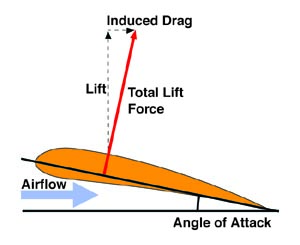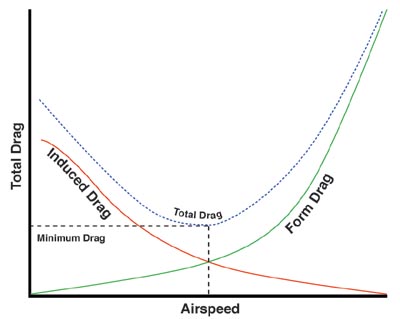Lift-induced drag
|
|
In aerodynamics, lift-induced drag, or more simply, induced drag, is a drag force arising from the generation of lift by wings or a lifting body during flight.
As a wing moves through the air, it generates lift both by accelerating the air downwards and by creating a pressure difference on either side of the wing. The pressure difference is caused by the Bernoulli effect, and does not contribute to induced drag. However, deflecting the air downwards generates both a lifting force and a drag force, and this drag force is induced drag. Induced drag is therefore directly related to the angle of attack of the wing, as a wing with a high angle-of-attack will see a greater backwards force as it accelerates the air downwards than a wing with a low angle of attack. However the higher angle of attack also generates more lift. The airspeed around the wing influences how much lift and, correspondingly, how much drag is generated. Thus, when an airplane is moving slowly, it must use a high angle of attack to generate the requisite lift, even though this causes a lot of induced drag. However, as the airplane speeds up, it can use a lower angle of attack to generate the same amount of lift, and the induced drag is thereby reduced. Thus, for practical purposes, induced drag may be related to airspeed rather than angle of attack, and we can simply say that there is an inverse relationship between the two. Induced drag is also inversely proportional to wingspan because a wider-span wing will generate more lift at a given angle of attack than a narrow one.Wingtip vortices are sometimes described as a component of induced drag, however this is incorrect. Though wingtip vortices do cause some drag, this drag is parasitic in nature. However, wingtip vortices also have the effect of destroying much of a wing's lift. Thus, in order to compensate for them, the wing must fly at a higher angle of attack, thereby causing more induced drag. The wingtip vortices do not directly cause induced drag though.
Induced drag must be added to the parasitic drag to find the total drag. As discussed above, induced drag becomes less of a factor the faster the aircraft flies because at higher speeds a smaller angle attack is required for the same amount of lift. The opposite occurs with parasitic drag (the drag caused simply by pushing the aircraft through the air), which increases with speed. The combined overall drag curve therefore shows a minimum at some airspeed - an aircraft flying at this speed will be at or close to its optimal efficiency. Pilots will use this speed to maximise endurance (minimum fuel consumption), or maximise gliding range in the event of an engine failure.


